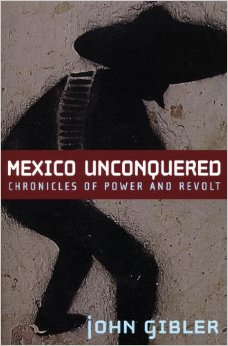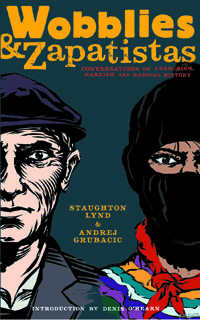Mexico Unconquered and Wobblies and Zapatistas

Power from Below
Mexico Unconquered:
Chronicles of Power and Revolt
By John Gibler
City Lights Books, 2009
356 pages, $16.95
 Wobblies and Zapatistas:
Wobblies and Zapatistas:
Conversations on Anarchism, Marxism,
and Radical History
By Staughton Lynd and Andrej Grubacic
PM Press, 2008, 300 pages, $20.00
It is welcome to see two new entries at the bookstore on the Zapatistas and related revolutionary movements in Mexico—issues that have slipped from the U.S. headlines even as nightmarish violence escalates rapidly just across the border. Both of these books also have something to add to the long debate about armed struggle and how it relates to unarmed, civil popular movements.
John Gibler’s Mexico Unconquered is most useful in its first-hand reportage from across a swath of social struggles. Gibler speaks with peasants in impoverished villages of Guerrero and Michoacán, where residents are terrorized by security forces acting under the rubric of drug enforcement. From the U.S. border, he offers a chilling interview with a pollero who smuggles desperate migrants across the line—proffering a perilous desert journey for an exorbitant price. He portrays a lawless society in which the poor are left with the choices of submitting to hunger and humiliation, heading north, or fighting back.
Gibler visits the Zapatista rebel zones in the jungle canyons of Chiapas, where Maya peasants have for 15 years been constructing their own living model of indigenous autonomy—an armed movement that has managed to survive and maintain its turf through political rather than military means.
Two civil movements Gibler focuses on are those at the village of Atenco in central Mexico, which was brutally occupied by police following protests in 2006, and in the southern state of Oaxaca, which saw a popular uprising against a corrupt governor that same year. The Oaxaca movement included marches and sit-ins but also “throwing rocks at the riot police [and] burning tires at the barricades.”
Gibler’s most important contribution is his prison interview with Gloria Arenas—“Colonel Aurora” of the Revolutionary Army of the Insurgent People (ERPI). Arenas was arrested in 1999, along with her husband Jacobo Silva Nogales (“Comandante Antonio”) and charged with leading the guerrilla movement in the mountains of Guerrero. She tells how she was politicized in her youth in the Sierra Zongolica of Veracruz, where campesinos faced repression for organizing to defend their lands from rapacious logging operations. The 1998 massacre at Guerrero’s El Charco village—where soldiers killed several ERPI militants and civilian sympathizers in a surprise attack on a schoolhouse—is related. And new light is shed on the ERPI’s emergence from the more Leninist and doctrinaire Popular Revolutionary Army (EPR).
Arenas cites the Zapatistas’ ethic of mandar obedeciendo (command by obeying) as offering a more democratic alternative, in which decision-making power flows up from the base rather than being imposed from above. She also speaks of armed struggle as part of a praxis with civil social movements, a tactic to be used “depending on the circumstances, but not defined by dogma independently of experience.” (True to form, the EPR issued orders for Comandante Antonio’s death when he broke away to form the ERPI.)
More theoretical and frankly meandering is Wobblies and Zapatistas, a series of interviews between anarchist scholar Andrej Grubacic and the revered radical historian, conscientious objector, and veteran antiwar and civil rights activist Staughton Lynd. The conversation starts out with the Chiapas rebellion and the Industrial Workers of the World—“the Zapatistas of yesteryear,” in Lynd’s phrase—but makes brief stops with the community organizing efforts of former steelworkers in post-industrial Youngstown, the 1946 general strike in Oakland, the Vietnam-era antiwar movement, and the 1980s revolutionary upsurges of Central America. Lynd ties it all together with his concept of “accompaniment”—basically, throwing one’s lot in with oppressed, sharing the burdens and risks of their struggles.
Grubacic and Lynd are concerned with the potentialities of movements that seek fundamental social change “without taking over the state,” drawing from both a Marxist analysis of capitalism’s dynamics and an anarchist critique of centralized power. While they are clearly inspired by the Zapatistas, Lynd acknowledges that the Chiapas revolutionaries have fallen short of their ambitions to build a unified movement across Mexico. He also concedes that their intransigent opposition to traditional political parties (even of the left) has been criticized by some Mexican activists and commentators as counterproductive—helping to bring the right to power.
Lynd brings a similarly nuanced analysis to the question of nonviolence, speaking of his personal commitment to the principle and how it developed in the antiwar movement of the 1960s, how he perceives its applicability to many of the struggles discussed—yet without portraying it as an absolute or uniform solution.
Grubacic is from the former Yugoslavia, and inevitably this discussion touches on the question of “humanitarian intervention”—unfortunately occasioning the book’s one failure of intellectual honesty. Grubacic’s question is contemptuously dismissive of those who are concerned about Darfur and Tibet or were concerned about Kosova ten years ago. And Lynd’s answer is just as bad, summing up U.S. war aims in the Balkans as “to destroy the last vestiges of public ownership in Serbia,” without even mentioning the ethnic cleansing. There may be a case to be made that U.S. war aims were those he depicts, and there is certainly a good case against “humanitarian intervention” as counterproductive hubris. But failure to even acknowledge the atrocities is simply dodging the question. One would hope for words that would encourage solidarity between the Zapatistas and the Bosnians, Kosovars, or Tibetans—rather than a glib betrayal of the latter groups.
Lynd is more honest on the limitations and complexities of nonviolence when he looks into U.S. history. He acknowledges the critical role of the abolitionists—“the strongest nonviolent movement in United States history,” at least up to that point. But he also acknowledges that it was the Union army and its merciless war that ultimately destroyed the slave system. “Could slavery have been ended in any other way?” he asks. “Was this humanitarian intervention justified? I do not know the answer.”

 War Tax Resistance: A Guide To Withholding Your Support from the Military
War Tax Resistance: A Guide To Withholding Your Support from the Military